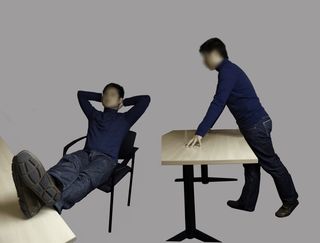Testosterone
Why You May Want to Stand Like a Superhero
Stand like a hero, and you might act like a hero. But there's a catch.
Posted July 14, 2011 Reviewed by Lybi Ma
Key points
- The "superhero" stance projects power, which is what psychologists refer to as an open posture.
- Research shows that assuming a high-power pose can raise an individual's testosterone levels.
- High-power posers report feeling more powerful than low-power posers.

You're probably familiar with what I'll call the "superhero stance"—the physical pose in which the superhero stands with legs spread apart, arms on hips, and elbows bent. The superhero stance projects power. It's an example of what psychologists refer to as an open posture, in which limbs are spread out in a way to take up more space—such as legs apart. Open postures contrast with closed postures, in which the body takes up relatively little space. Numerous psychological studies have demonstrated that open postures convey a sense of the individual having power and closed postures convey a sense of the individual having little power (Carney, Hall, & Smith LeBeau, 2005; de Waal, 1998; Hall, Coats, & Smith LeBeau, 2005).
Can assuming the superhero stance make you feel and act that way and even alter your hormone production?
That's what researchers Dana Carney, Amy Cuddy, and Andy Yap wanted to know. (They didn't specifically examine the superhero stance, but they did look at two other similar open postures.) Here's what they did: Participants (male and female) were randomly assigned to pose in either two "high power" or two "low power" positions. The experimenter physically posed each participant in the poses.

High-power poses were sitting in a chair, arms behind the head, elbows out, and feet up on a desk (like a boss "relaxing"), and standing in front of a table, legs about a foot apart, leaning forward and hands on the table bearing weight. Both these poses take up a lot of space for sitting and standing, respectively.
In contrast, the two low-power poses had those participants taking up little space—in the sitting version, participants sat straight up, feet on the floor, legs at a 90-degree angle, and hands on the lap with elbows in, touching the sides. The low-power standing pose had participants put their legs close together and their arms were placed as if they were giving themselves a hug. Participants in all groups held each pose for one minute.

Afterward, participants moved on to a gambling task, in which they were each given $2. Then they had the option of either not gambling (keeping the money, no risk involved) or taking a risky opportunity to roll a die and either double their money or lose the $2 altogether; they were told that the odds were 50/50.
What's the purpose of this part of the study? To see whether assuming either a high-power or low-power pose led participants to behave accordingly—to be more willing to assume risk (high power, with the theory that if you're powerful, you're more willing to assume risk), or play it safe (low power). Participants were also asked to rate how powerful they felt, on a scale from 1 (not at all) to 4 (a lot).
The researchers also took saliva samples at the start of the study (to establish a baseline) and 17 minutes after the last pose; through the saliva, they could measure a hormone associated with power (testosterone) and a hormone associated with stress (cortisol). Why these hormones? Previous research on testosterone and power indicates that one's testosterone level increases when a person anticipates competing, as well as after winning, but that one's testosterone level drops when an individual loses (e.g., Booth, Shelley, Mazur, Tharp, & Kittok,1989). In other words, testosterone goes up with the possibility of or with actual power and decreases when power—or the opportunity to attain power—is lost.
Cortisol is sometimes referred to as a "stress hormone" because its levels often rise with stress. People who are powerful tend to have lower baseline levels of cortisol and, when stressed, their cortisol levels don't rise as much as it does in people who are relatively powerless (Abbott et al., 2003; Coe, Mendoza, & Levine, 1979; Sapolsky, Alberts, & Altmann, 1997). Chronically high levels of cortisol are associated with various stress-related illnesses such as high blood pressure (Sapolsky et al., 1997), and these illnesses are more common in social groups that have low power than in those who have high power (Cohen et al., 2006).
Based on past findings of testosterone and cortisol, the researchers wanted to see whether assuming a pose for such a short amount of time would lead the brain to shift hormonal gears and create the typical high-power or low-power hormonal pattern. The answer was "yes": Participants who assumed high-power poses had their testosterone levels increase relative to their baseline, while participants who assumed low-power poses had their testosterone levels drop. The reverse was true of cortisol levels.
More importantly, the researchers wanted to know whether posing in high- or low-power positions would lead participants to adopt the behavioral pattern typical of the power level associated with their pose. This answer, too, was "yes": While 60% of low-power posers chose to risk gambling their $2, 86% of high-power posers risked their money. (When reading about these results, I couldn't help but think of folks who work in the financial sector who no doubt regularly assume high-power poses as they jockey for promotions, for recognition, or to make a good impression. Perhaps assuming that pose leads them to be willing to risk too much? Perhaps that culture should encourage a more of a closed position, or at least something in the middle?) High-power posers also reported feeling more powerful than low-power posers, with an average rating of 2.57 versus 1.83, respectively.
So it seems that participants who assume a couple of superhero-type stances for a grand total of two minutes feel more powerful and act that way: Stand like a superhero, feel like a superhero, act like a superhero.
Does this mean that when Clark Kent hunches and tries to make himself look less powerful, his testosterone levels decline and his cortisol levels rise? Does he take fewer risks as Clark than when he's standing tall in his boots and cape? Does he feel less powerful? If he's like us, the answer appears to be "yes."
There is a wonderful scene in the first Superman film, by Richard Donner, in which Clark Kent and Lois Lane are about to go out and grab dinner. Clark is in Lois Lane's apartment waiting for her to get a sweater. As Superman, he has just finished being interviewed by Lois and flown her around Metropolis. She is star-struck. As Clark waits for Lois, he's hunching over, trying to appear timid and unpowerful. He has a moment when he decides to tell Lois his real identity; he stands up tall, takes his glasses off and changes the tilt of his head. His body fully assumes a position of power and it is a pleasure to watch this embodiment of power as he allows himself to take up more space. Christopher Reeve did a fantastic job in that scene.
Copyright 2011 by Robin S. Rosenberg. All rights reserved.
References
Abbott D.H., Keverne E.B., Bercovitch F.B., Shively C.A., Mendoza S.P., Saltzman W., et al. (2003). Are subordinates always stressed? A comparative analysis of rank differences in cortisol levels among primates. Hormones and Behavior, 43, 67-82.
Booth A., Shelley G., Mazur A., Tharp G., Kittok R. (1989). Testosterone and winning and losing in human competition. Hormones and Behavior, 23, 556-571.
Carney D.R., Cuddy, A. J. C., Yap, A. J. (2010). Power Posing: Brief Nonverbal Displays Affect Neuroendocrine Levels and Risk Tolerance. Psychological Science, 21, 1363-1368.
Carney D.R., Hall J.A., Smith LeBeau L. (2005). Beliefs about the nonverbal expression of social power. Journal of Nonverbal Behavior, 29, 105-123.
Coe C.L., Mendoza S.P., Levine S. (1979). Social status constrains the stress response in the squirrel monkey. Physiology & Behavior, 23, 633-638.
Cohen S., Schwartz J.E., Epel E., Kirschbaum C., Sidney S., Seeman T. (2006). Socioeconomic status, race, and diurnal cortisol decline in the Coronary Artery Risk Development in Young Adults (CARDIA) study. Psychosomatic Medicine, 68, 41-50.
de Waal F. (1998). Chimpanzee politics: Power and sex among apes. Baltimore, MD: Johns Hopkins University Press.
Hall J.A., Coats E.J., Smith LeBeau L. (2005). Nonverbal behavior and the vertical dimension of social relations: A meta-analysis. Psychological Bulletin, 131, 898-924.
Sapolsky R.M., Alberts S.C., Altmann J. (1997). Hypercortisolism associated with social subordinance or social isolation among wild baboons. Archives of General Psychiatry, 54, 1137-1143.




